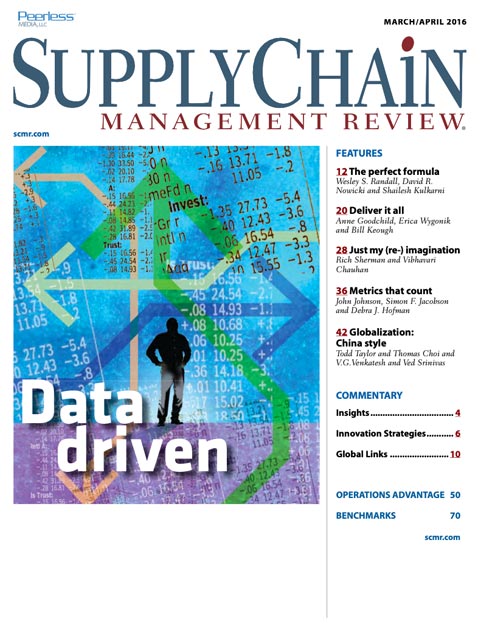Sorry, but your login has failed. Please recheck your login information and resubmit. If your subscription has expired, renew here.
March-April 2016
When I visit my millennial-aged daughter in Chicago, I’m amazed at the number of packages dropped off by UPS, FedEx and the USPS at her three-unit building on a daily basis. It’s as if she and her neighbors are single-handedly keeping Amazon in business. All those drop-offs got me to wondering: Does any of this make sense if you think about a carbon footprint? Rather than deliver millions of packages to one address at a time every day, wouldn’t it be more sustainable if we all just drove to the mall to do our shopping? After all, doesn’t research indicate that a signi cant percentage of consumers, especially millennial consumers like my… Browse this issue archive.Need Help? Contact customer service 847-559-7581 More options
Having the right amount of inventory when and where it’s needed is a key element of corporate success. After all, losing control of inventory eats away at corporate profit margins and costs a firm its customers. As a result, today’s CEOs are well versed in inventory strategies such as Just-in-time (JIT), collaborative planning, forecasting and replenishment, and shared point of sale data. Yet, the wrong application of the right strategy can be just as costly as no inventory control at all. Reducing the wrong inventory, for instance, often leads to a reduction in customer service levels (CSL) with little impact on cost. That affects customer satisfaction. Strategies such as JIT, on the other hand, often simply shift the cost of carrying inventory back to the vendor with little impact on the total end-to-end total supply chain cost. Eventually, those costs affect all of the players in the supply chain.
The result is that supply chain executives are often left scratching their heads and wondering: How can I manage inventory in a way that doesn’t impact my customers or leave real money on the table?
Our work answers these questions using a new inventory strategy that we call the science of theoretical minimums, or STM. STM provides a simple and elegant framework to reduce cost and increase customer service levels by monetizing time delays across the extended supply chain. Unlike other strategies, managing to theoretical minimums reduces the total supply chain cost instead of simply pushing costs onto weaker suppliers. This means that STM reveals how much profit is being left on the table in the end-to-end supply chain. This monetization of delay cost provides supply chain executives with a clear picture on where to focus their efforts.
 |
This complete article is available to subscribers
only. Click on Log In Now at the top of this article for full access. Or, Start your PLUS+ subscription for instant access. |
SC
MR
Sorry, but your login has failed. Please recheck your login information and resubmit. If your subscription has expired, renew here.
March-April 2016
When I visit my millennial-aged daughter in Chicago, I’m amazed at the number of packages dropped off by UPS, FedEx and the USPS at her three-unit building on a daily basis. It’s as if she and her neighbors are… Browse this issue archive. Access your online digital edition. Download a PDF file of the March-April 2016 issue.
 |
Download Article PDF |
Having the right amount of inventory when and where it's needed is a key element of corporate success. After all, losing control of inventory eats away at corporate profit margins and costs a firm its customers. As a result, today's CEOs are well versed in inventory strategies such as Just-in-time (JIT), collaborative planning, forecasting and replenishment, and shared point of sale data. Yet, the wrong application of the right strategy can be just as costly as no inventory control at all. Reducing the wrong inventory, for instance, often leads to a reduction in customer service levels (CSL) with little impact on cost. That affects customer satisfaction. Strategies such as JIT, on the other hand, often simply shift the cost of carrying inventory back to the vendor with little impact on the total end-to-end total supply chain cost. Eventually, those costs affect all of the players in the supply chain.
The result is that supply chain executives are often left scratching their heads and wondering: How can I manage inventory in a way that doesn't impact my customers or leave real money on the table?
Our work answers these questions using a new inventory strategy that we call the science of theoretical minimums, or STM. STM provides a simple and elegant framework to reduce cost and increase customer service levels by monetizing time delays across the extended supply chain. Unlike other strategies, managing to theoretical minimums reduces the total supply chain cost instead of simply pushing costs onto weaker suppliers. This means that STM reveals how much profit is being left on the table in the end-to-end supply chain. This monetization of delay cost provides supply chain executives with a clear picture on where to focus their efforts.
 |
SUBSCRIBERS: Click here to download PDF of the full article. |
SC
MR

Latest Supply Chain News
- Supplier, vendor inequality hinders supply chain’s competitive edge
- 5 strategies for energy market cost and risk reduction
- 5 strategies for energy market cost and risk reduction
- Managing inflationary price risks in supplier-buyer contracts through indexing
- Balanced supply chain management: Setting the stage
- More News
Latest Podcast

 Explore
Explore
Topics
Latest Supply Chain News
- Supplier, vendor inequality hinders supply chain’s competitive edge
- 5 strategies for energy market cost and risk reduction
- 5 strategies for energy market cost and risk reduction
- Managing inflationary price risks in supplier-buyer contracts through indexing
- Balanced supply chain management: Setting the stage
- The state of procurement
- More latest news
Latest Resources

Subscribe

Supply Chain Management Review delivers the best industry content.

Editors’ Picks





